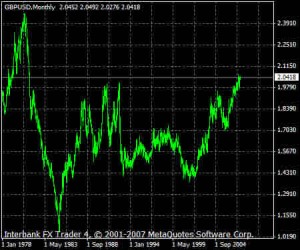Forex Trends – Forex Trend Trading
Identifying Forex trends by technical analysis is a key concept in Forex trading and one of the most reliable indicators of future market direction. Forex trends are defined simply as the direction in which a currency pair has been moving for an extended period of time. When it comes to Forex trading the expression “the trend is your friend” could not be more true.
Forex trends exist in all time frames and across all currency pairs. They can be classified in one of three ways:
Uptrend – In an uptrend an asset rallies often with intermediate periods of consolidation or minor movements against the trend. It will show a series of Higher Highs (HH’s) and Higher Lows (HL’s) on the chart.
Downtrend – In a downtrend an asset declines often with intermediate periods of consolidation or minor movements against the trend. It will show a series of Lower Lows (LL’s) and Lower Highs (LH’s) on the chart.
Non-Trending – The price value of the asset will often swing back and forth for long periods between defined upper and lower limits. There will be no apparent directional movement of the price (HH’s & HL’s or LL’s & LH’s). This is sometimes referred to as ‘sideways’ or ‘range bound’ movement.

Take a look at the AUD/USD Daily chart above. Simply by looking at the chart we can see visually that the pair is in an uptrend. The presence of this uptrend is further confirmed by the price action making a succession of higher highs (green) and higher lows (red) on the chart as the trend advances upwards.
A common way to employ Forex trend trading is to enter a position when there is a pullback to a support level within the trend. At this point a trader could enter a long position (buy) in the direction of the current trend. In the above example, this would mean entering long at the higher lows shown in red on the chart. This technique is known as “buying on dips”. A stop-loss for the trade would be placed below the lowest point that the price had traded in each pullback.
The opposite approach could be used for a market in a downtrend. The downtrend is identified when the pair has been building lower highs (green) and lower lows (red).
In the example of the USDJPY below, the trader would wait for a pullback to a level of resistance (green) and then take a short position in the direction of the trend. In this example a stop would be placed above the highest point to which the pair traded in the pullback. This approach is often referred to as “selling on market rallies”.

The key point to note from this lesson is that by trading in the direction of the dominant Forex trends, you will have market momentum behind them. This helps to de risk any open trading positions as you have the ‘backing’ of the market.
While it is of course possible to identify trades against the trend, any profits earnt in this way will come with a much greater level of risk attached to the trade. This is because you are effectively buying against the predominant direction of the market.
Forex trends persist over time and can last for weeks, months or even years. A longer term monthly trend may contain several shorter term daily or weekly trends within it. As with Support and Resistance levels that we look at next, a general rule of thumb is the longer the timeframe the stronger the trend.
When trading Forex you should ensure that you check for established trends running daily, weekly, monthly or even over a number of years. Even when a short term Forex trend breaks down, longer term trends are likely to persist.



